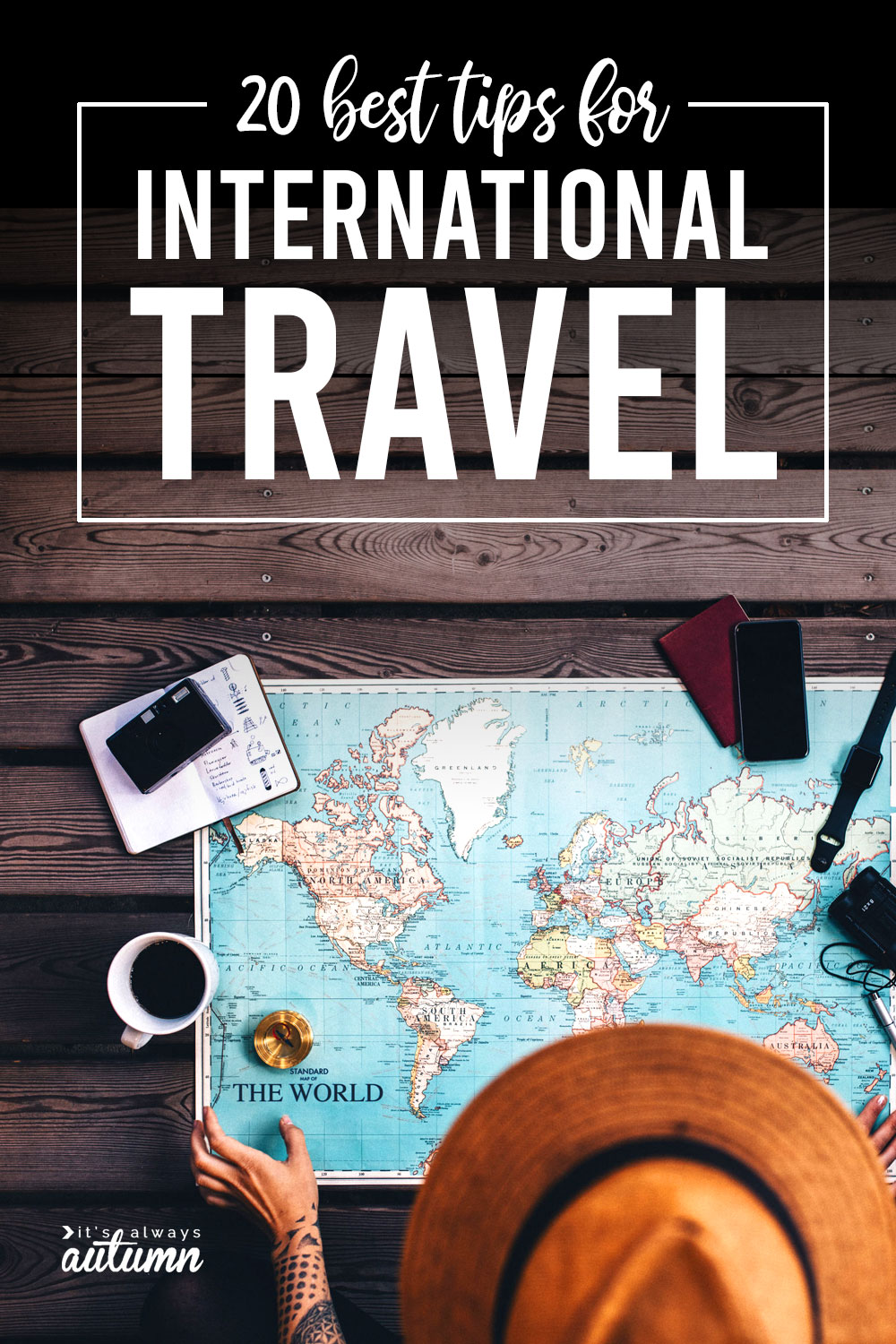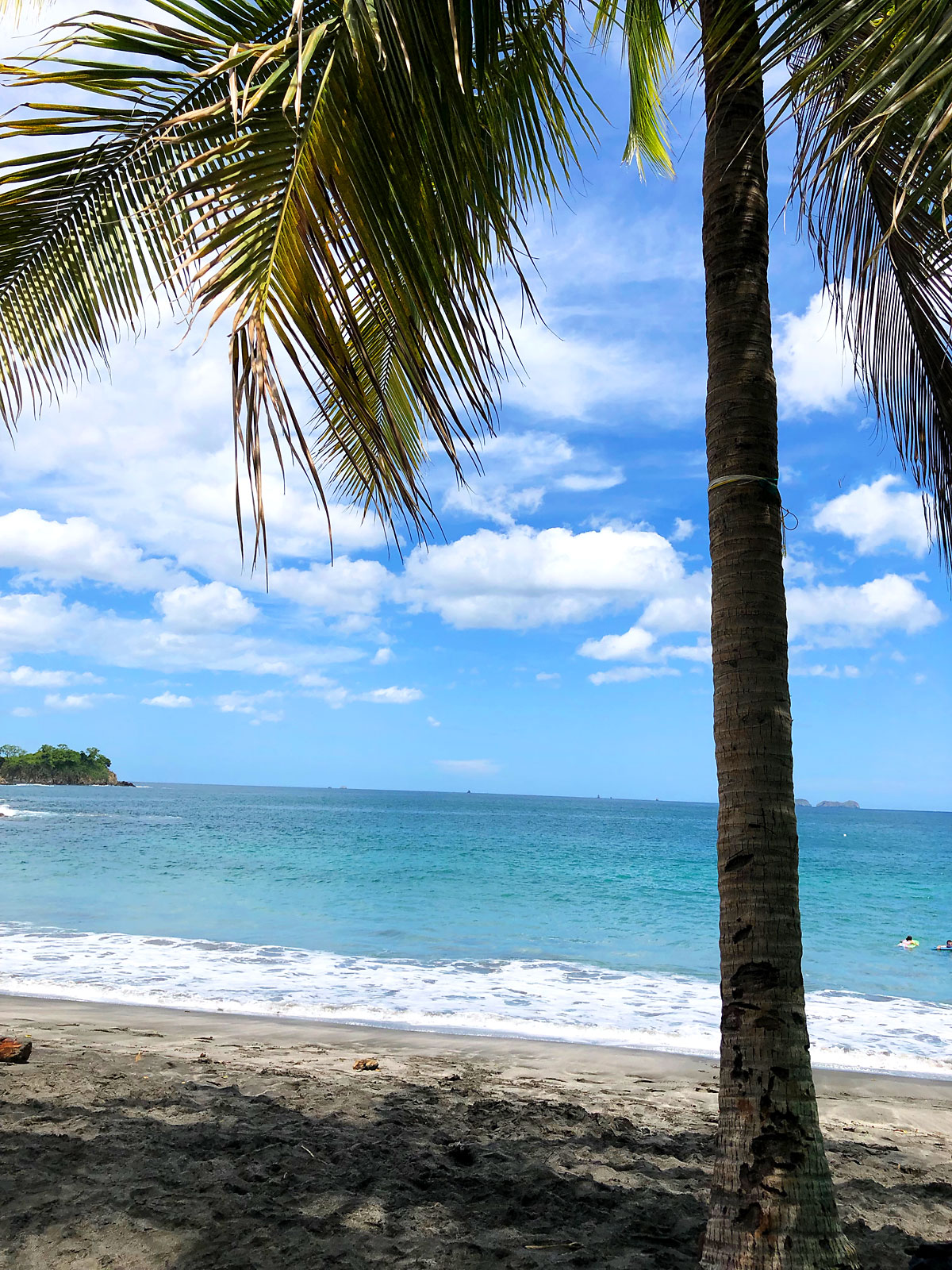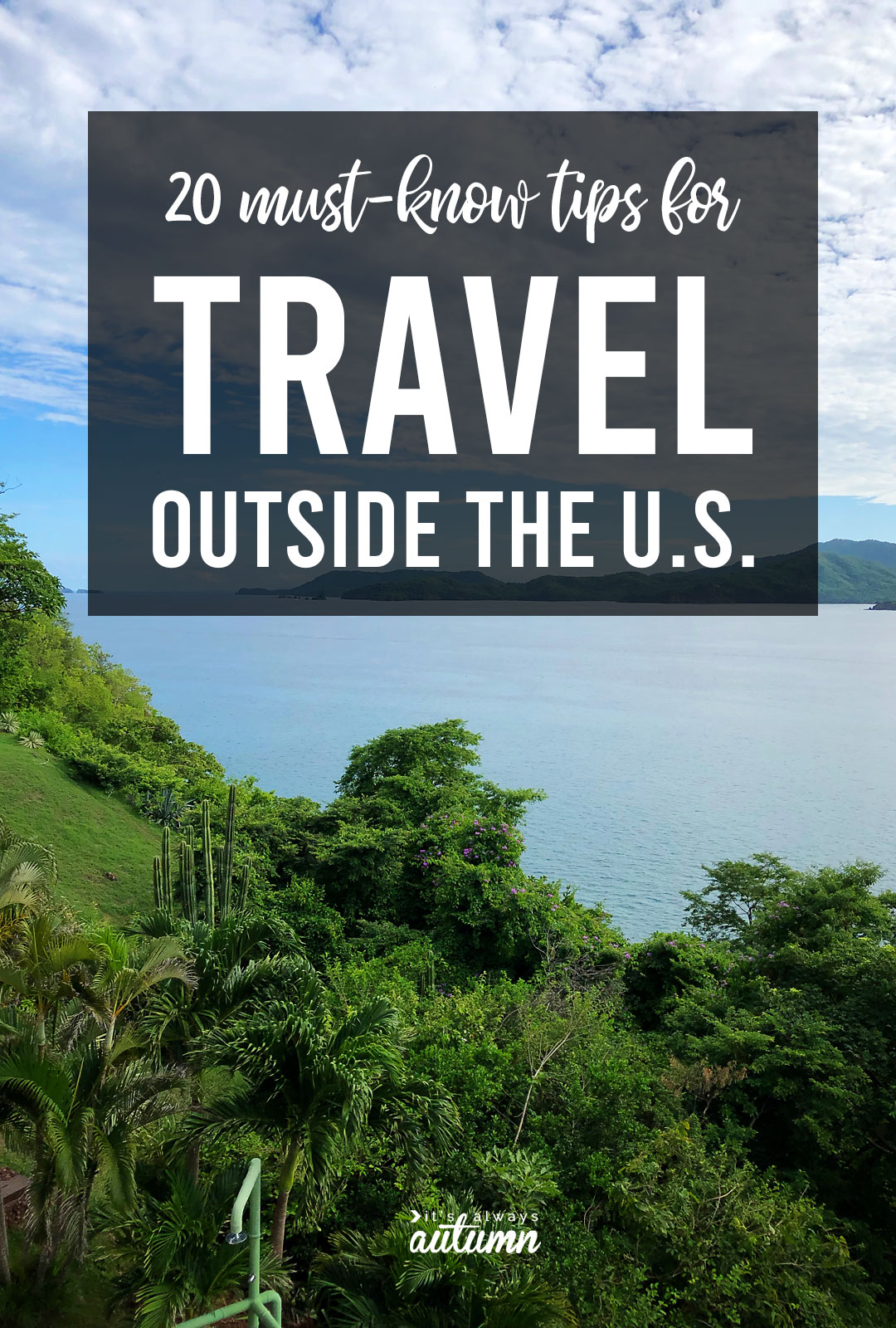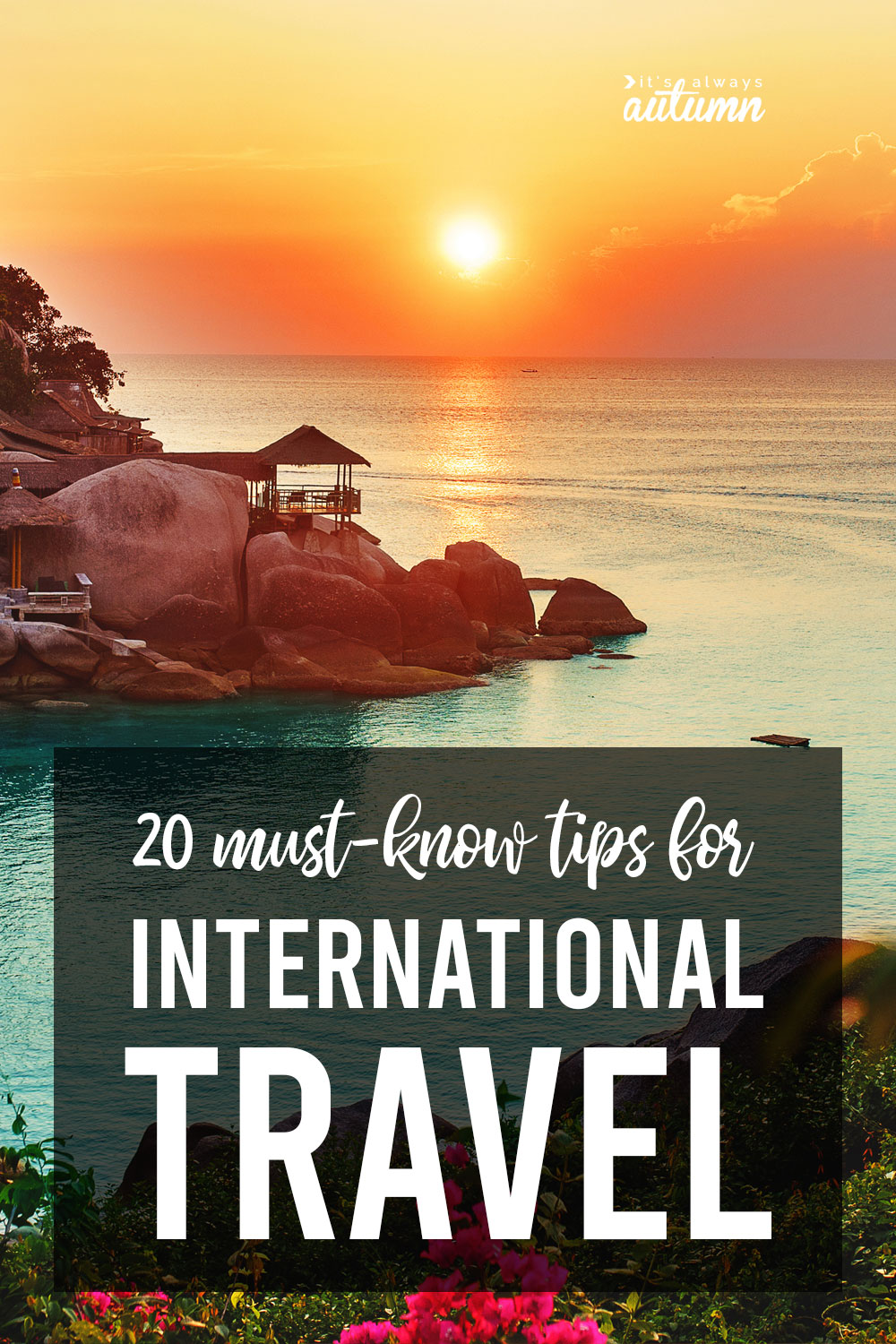In today’s post: Thinking about traveling outside the United States? Find the answers to the most common questions about international travel + helpful hints for things you may not have considered!
I recently planned a trip to Costa Rica for my 20th wedding anniversary. I grew up traveling internationally fairly often, but it’s been over 20 years since the last time I left the country. So I was a bit intimidated and overwhelmed by all the things I didn’t know: Can I renew my old passport or do I need a new one? How do I know if our destination will be safe? Can we drink the water there? Do I need shots before I go? What about exchanging money? And on and on.
These sorts of questions can make international travel intimidating, but they shouldn’t keep any of us from planning an amazing trip! Today I’m going to answer the most common questions about international travel, show you where to go to get reliable information you can trust, and throw in a few helpful hints you may not have considered. Here’s to planning the vacation of your dreams!
Photo credit [ammentorp] © 123RF.com
Note: I’m sharing lots of info I’ve learned below, but I’ll also point you to sites where you can get the best information for your international travel. Please visit these sites to verify the information that you need for your trip and do additional research as necessary.
How do I get a passport?
Nearly all international travel from the US requires a US passport. There are two types of passports: a passport book and a passport card. A passport book is what you’ll need for most international travel, and it currently costs $110 for an adult or $80 for a child. A passport card is much cheaper ($30), but it is only valid for travel by land or sea to Canada, Mexico, Bermuda, and the Caribbean.
Visit the Travel section of the US State Department website for instructions on how to apply for a new passport or renew an expired passport.
It can seem confusing, but getting a passport is a fairly straightforward process. You will be able to fill out the application form online, whether you are renewing or applying for a new passport.
For a renewal, you can mail in all the required paperwork and the fee. You’ll receive your new passport in the mail.
For a new passport, or if your last passport was issued over 15 years ago, you will need to appear in person at a local passport office to turn in all your paperwork and pay your fee. You can search your state name and “passport office” to figure out where to go and whether you can walk in or should make an appointment in advance. Even though you turn everything in at the office, you will receive your new passport in the mail.
For a new passport or a renewal, you will need:
- passport photo
- application
- photo ID and a photocopy of your photo ID
- proof of citizenship (usually either a birth certificate or an expired passport)
Your proof of citizenship will have to be submitted with your passport application, meaning they will take your actual birth certificate or expired passport, not a copy. Those documents will be mailed back to you, and they are usually received a few days after the passport is.
Right now the State Department says the processing time for a passport is 6-8 weeks. (You can check the link above for current information.) That means it’s a good idea to apply for your passport about three months before your trip. If you are traveling sooner than that, check the website above for info on expedited service, which will require an is additional fee.
Helpful hint: Some passport offices can take your passport photo, while other offices do not offer photo services. We found it simplest and cheapest to get our passport photos taken at Costco.
Helpful Hint: Once your passport arrives, make a photocopy of the page with your photo and passport number and place that in a separate area in your travel bag. If your passport is lost or stolen, having a copy will make getting it replaced much easier! While you’re at it, take copies of your credit cards. If they are lost or stolen you’ll want easy access to your credit card number and the phone number of the card company that’s usually on the back. Just remember to keep the copies is a safe place.
Do I need a visa?
A United States passport gives you permission to leave and re-enter the US. Your destination country may also require a travel visa which allows you to enter and stay in their country. The requirements vary on a country by country basis. Visit the Country Information page on the US State Department website to learn about the visa requirements for different countries.
What’s the deal with immigration and customs?
You will have to pass through immigration and customs when you reach a foreign country and again when you return to the United States. You’ll receive a form on your flight to fill out (one per family) and present when you go through immigration (which is called passport control in many countries). The form will ask for basic information including your passport number, where you will be staying, your flight number, etc. It will also ask if you are transporting food, plants, animals, etc. When you get to your destination you’ll have to stand in a line to go through immigration (passport control) where an employee will check and stamp your passport. Then your baggage will go through customs, which may include sending it through a scanning machine, or spot searches, or nothing at all.
Sometimes going through immigration and customs takes 15 minutes; sometimes it takes 2 hours or more. It varies by airport and time of day. Remember that you’ll go through immigration and customs after you land in each country, even if you then have another flight to another city, so make sure you have plenty of time in between flights to allow for this. For example, we flew back from Costa Rica via Los Angeles airport. Even though LA was not our final destination, it is where we went through immigration and customs and it took 2 full hours to do so. Luckily we had a long layover in LA and were able to make our next flight with no problem, but many people in the line were saying they were going to miss their connecting flights because the lines were so long.
Is it safe to travel outside the US?
One of our main concerns when deciding where to travel for our anniversary was safety. We wanted to know if crime rates were high in the areas we were considering, and whether we could trust that local law enforcement would be helpful if there was a problem. It can be hard to get accurate info if you’re just relying on advice from other travelers, so I was happy to discover that the US State Department publishes Travel Advisory levels for all other countries.
Visit the Country Information page on the US State Department website and enter in the country you’re interested in visiting. You’ll find a wealth of information about that country, including the Travel Advisory levels. The possible levels are:
- Level 1: Exercise Normal Precautions
- Level 2: Exercise increased caution
- Level 3: Reconsider Travel
- Level 4: Do Not Travel
Helpful hint: Remember that theft is often an issue in any tourist destination, even those with a Level 1 rating. Before you travel, buy a money belt or pouch that you can wear under your shirt – these are much harder for pickpockets to get to. Always be aware of your surroundings and don’t leave belongings unattended.
Do I need shots or extra vaccinations to travel outside the US?
Remember that anytime you are planning to travel out of the country you and your family should be up to date on all routine vaccinations. In addition, travel to some foreign countries will require vaccinations (or certain vaccines are heavily recommended). The best way to find out if the location you are traveling to requires additional vaccines is to visit the Travel page at the CDC website and enter in your destination.
Once you find out what vaccinations you need, you can usually visit your local health department to receive the vaccines as well as a travel consultation. Going to the health department is a good idea as your doctor’s office probably won’t stock the vaccines that are only required for international travel. A travel consultation at the health department can help you determine if you need new a new Tetanus booster or if any other recommended vaccines are out of date. Additionally, there may be specific vaccines or medications that are either required or highly recommended for travel to certain areas (i.e. places where Yellow Fever or Malaria are a known problem). Do not wait until right before your trip to do this! Some vaccines cannot be given too close to each other, and sometimes there are shortages on travel vaccines. For example, right now the Yellow Fever vaccine is required for travel to and from certain countries. Not only is there a current shortage for the vaccine, you are supposed to receive it at least 10 days before you leave, and you may not be able to receive it at the same time you receive other vaccines. So advance planning is necessary.
Helpful Hint: If you are traveling to an area with mosquito borne illness, be sure to pack an effective bug spray. We used this bug repellant with 98% DEET when hiking through the rain forest in Costa Rica. Please check with your doctor for a recommendation, as products with this much DEET may not be suitable for children.
Helpful Hint: The CDC travel site also gives lots of other health information, like whether the food and water is safe to consume in the area you’re traveling to. It’s a good idea to read through the entire page for your destination.
Helpful Hint: Even if you are traveling to a country where the food and water are considered safe to consume, it’s possible to pick up a bug your stomach isn’t used to, which may result in traveler’s diarrhea. Visit your doctor before your trip and ask about getting antibiotics you can take with you just in case.
Will my cell phone work outside of the country?
Be sure to check with your cellular provider to find out what, if any, international calls and data are included on your phone plan. Often you can add a temporary international upgrade to your cell phone plan that will be MUCH cheaper than using your phone without an international plan. The international plan may only cover data, not calls. If this is the case, plan to use text and FaceTime talk instead of making calls.
Helpful hint: If your phone is unlocked, you may be able to purchase local SIM cards at your destination that provide you with a local number. This can be even cheaper than adding an international upgrade to your cellular plan. Search for more information specific to your travel plans.
Will my electronics work in other countries?
There are two possible differences in electric outlets between those in the United States and those in other countries: plug type and voltage type. Plug type is the shape/style of the plug, while voltage refers to how much electricity runs through the outlet. The United States uses 120 volts, whereas many international countries use 220-240 volts. So if you plug your U.S. hair dryer into a 220v socket and turn it on, you’re going to run into problems. If you plan to take many electrical things (like hair dryers) on your travels, you’ll likely want a power converter, which converts both the plug type and the voltage for you. This post from REI gives a good overview of plug type and voltages used in many different countries and can help you find the power converter you need.
Helpful Hint: Check with your hotel to see if they provide power converters in the hotel rooms.
If the only things you plan to plug in on your travels are cells phones, laptops, etc, you might not need a power converter. Most device chargers have dual voltage capabilities, meaning they’ll work fine at higher voltages. Check the small print on your charger and you’ll likely see something like this: “Input 100 – 240V, 50 – 60 Hz.” That means that charger is compatible with higher voltages, so you shouldn’t need a power converter. However, you may still need a plug adaptor to make sure your plug will fit the sockets in the country you’re visiting. Check with your hotel or accommodations for more info on what they recommend.
Should I exchange money in advance?
You may wonder if you should exchange money before you travel internationally, and how much. This will vary depending on your destination. If credit cards are widely accepted at your destination, you’ll usually get the best exchange rate by using cards instead of cash. Just be sure to tell the merchant you will pay in local currency; that means the credit card company sets the exchange rate. If you tell the merchant you’ll use your credit card and pay in U.S. currency, the merchant chooses the exchange rate.
Helpful Hint: Check with your credit card company to make sure they do not charge a foreign transaction fee. Many do not, but some cards still do, and if your card does you may end up with lots of extra fees!
You’ll likely want to carry some small bills in cash. Do an internet search before you go to find out if the country you are visiting generally accepts U.S. dollars. If they do, you can travel with some U.S. cash and use it for small purchases. You’ll often receive local currency as change, which you can use for tips, souvenir purchases etc. If the country you are visiting does not accept U.S. dollars, you’ll be able to exchange some money at the airport, although you’ll likely get a better rate at a local bank.
How do I figure out where to stay/what to do, etc?
These days it’s easy to find information online about hotels, condos, activities, etc. In fact, there’s so much information that it can be overwhelming. Even though you can get lots of info online for free, it can be helpful to purchase a travel book about the country you’re interested in visiting. That’s because books are organized and generally very good at giving an overview of an entire country or area, while the internet is kind of a free-for-all. A book can help you get familiar with the geography of your destination, which will make it easier to decide what general areas you’d like to visit. It can also give you really comprehensive information that you might miss if you only rely on online searches.
Once you have a good overview of where you’d like to visit, online research can be super helpful. Specifically, read reviews. You can find online reviews for just about anything these days! I like TripAdvisor – you can find reviews for hotels, beaches, excursions, restaurants, etc. You’ll often get more information from other travelers’ reviews than you can find on websites for some places you’d like to visit. And you’ll often be able to read reviews from just days previous, meaning you are getting updated information.
We often book condos through VRBO, Homeaway, or AirBNB. I LOVE that you can read reviews for each place you’re considering. Reviews will often tell you whether the condo comes stocked with beach gear and how well the air conditioning works, as well as how easy the owner was to work with, where you can park, how far the condo is from local sights, etc.
Helpful Hint: Remember that in the U.S. we are really accustomed to air conditioning, but it is not as common in other parts of the world! If having AC is important to you, be sure to verify that the place you stay actually has it, and check to see whether it is central air that will cool the entire place or just a window unit that may only cool one room.
Helpful Hint: When reading reviews, don’t fall into the rabbit hole. By that I mean don’t feel like you need to read every one of the 1453 reviews on the hotel you’re considering. Also, don’t believe every single thing every single person says (some people will complain about anything). Just look through the most recent couple of pages to get a general feel for other travelers’ experiences.
Obviously this doesn’t cover everything you need to consider when traveling outside the United States, but this should cover some of the most frequently asked questions. If you have more tips for international travel, I’d love for you to leave them in the comments – thanks!












Outdoormo says
I personally loved all your travel advice. Just waiting for this pandemic to end asap :((
Margot says
Love your advice about travel books vs. internet. I, of course, still use the internet as it is useful for current schedules, etc. When traveling with my young adult kids (who don’t live at home) we usually set up a shared Pinterest board for our destination. It helps make everyone aware of what others are interested in doing on the trip. It gives a little necessary distance so that we can each give more thought to activities we might not be so keen about and cuts back on the snarky feedback a face-to-face conversation can have. That said, when we travel with said kids we don’t do everything together, although it’s funny how often we run into each other on the days we are sightseeing on our own!
autumn says
A shared Pinterest board is a genius idea!
ELENA BRENES ARIAS says
Absolutely useful, no matter where you are from! Thanks!
Welcome to my beautiful country !! I follow your blog from CR.
I recommend you the northern Pacific coast, Guanacaste, sunset, white sand … just relax.
Tell me if I can help you with anything you need.
autumn says
Hi Elena! We did go to Guanacaste and it was absolute HEAVEN – the most beautiful place I’ve ever been! Everyone we met was so friendly. The trip was just wonderful. Thanks for saying hello!